100 years later, humans finally saw a black hole
From an astronomical perspective, 2019 can be described as the year of black holes.
This year, there have been multiple breakthroughs in black hole research. On April 10th, scientists released the first globally unique photo of a black hole; On November 28th, researchers from the National Astronomical Observatory of the Chinese Academy of Sciences discovered the largest stellar black hole in the Milky Way. In addition, American scientists also discovered the smallest mass black hole in the universe. Among these discoveries, there is no doubt that the first black hole photo is the most exciting one.
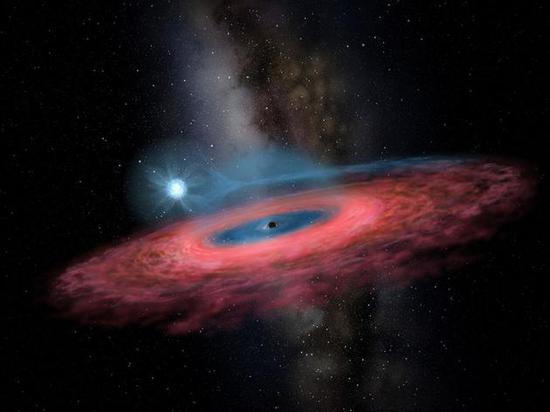
Artistic Imagination of LB-1, the Heaviest Stellar Black Hole in the Milky Way Galaxy
(by Yu Jingchuan)
In 1915, Einstein put forward the general theory of relativity. A few months later, Karl Schwarzschild, a physicist in the German trenches, obtained the exact solution of Einstein's equation. This solution is the solution of black holes as we know it now. There is no rotating black hole solution, which is also the first modern description of black holes.
In the next hundred years, human research on black holes has only remained theoretical, and we have almost no idea what black holes look like.
Until over the past decade, the development of technology has given humans the opportunity to pursue and explore the true appearance of black holes. Finally, in April 2019, over 300 scientists from 20 countries around the world jointly released the first black hole photo.
Through the history of black hole exploration, we can glimpse the long history of scientific development.
When it comes to black holes, we may have some fear because in many movies, black holes are described as "giants" who eat everything, even light and time can stop. However, in the eyes of some physicists, they are also very magical because they may play the role of time gates in the future, leading humans to quickly traverse the universe.
Overall, black holes are both mysterious and magical celestial bodies. Black holes have a very strong gravitational pull, so to understand them, we need to explore the development history of gravity.
History of the Development of Universal Gravitation
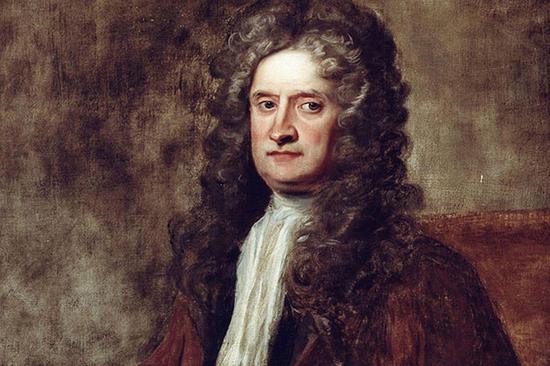
When it comes to gravity, naturally we think of the great physicist of the 17th century - Newton. Sitting under a tree and seeing a falling apple, he realized that there should be a universal force in the universe, which we now call universal gravity.
Newton was a great physicist who not only came up with this idea, but also "landed" it. He wrote a very classic formula based on this idea: the expression for universal gravitation. Through this formula, we know that he believes that gravity exists because an object has mass.
He summarized this theory in the classic book "Mathematical Principles of Natural Philosophy". After its publication, this theory has been highly praised by many people because it can not only explain the motion of celestial bodies in space well, but also perfectly predict the future motion state of celestial bodies.
In the following few hundred years, his theory was continuously verified and widely applied, not only in physics, but also in many other disciplines. Newton's theory can be said to be the origin of modern science, but by the 19th century, more observational discoveries had posed challenges to scientists. At the beginning of the 20th century, Einstein first proposed special relativity, and ten years later he proposed general relativity. In this new theory, he proposed a new perspective on gravity. He believed that gravity is not directly generated by mass, but by the curvature of cosmic spacetime caused by massive celestial bodies, and the curved spacetime presents a gravitational effect.
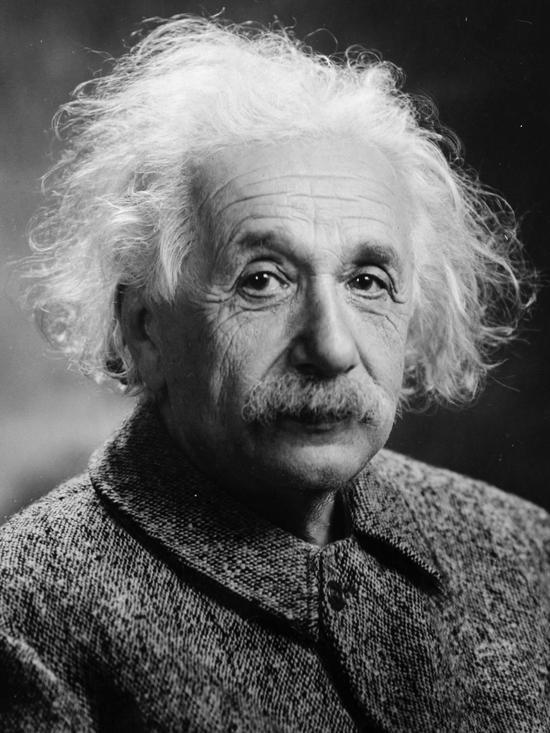
A few months after Einstein put forward the general theory of relativity, the German physicist Karl Schwarzschild got the exact solution of this complex equation. Unfortunately, although this exact solution is the exact solution of a black hole, it is a black hole that does not rotate, and almost all celestial bodies in the universe rotate, including the Earth. So, when Einstein saw this exact solution, although he was surprised, he did not believe that it really existed.
In the following decades, due to war and technological limitations, research on black holes can be said to have stagnated. Only in 1939, Oppenheimer and his students discovered that the collapse of massive stars could form a singularity, which is now known as a black hole. In addition, there has not been much progress in the study of black holes.
Because no trace of black holes had ever been observed, Einstein did not believe in the existence of mysterious celestial bodies such as black holes until his death in 1955.
Thirty Years of Black Hole Research on Gold
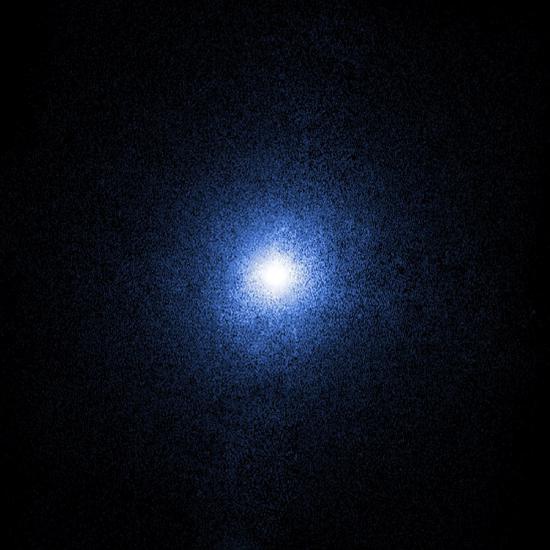
The X-1 picture of Cygnus taken by Chandra X-ray Observatory. Source Wikipedia
In the 1960s, in 1963, New Zealand mathematician Cole obtained another exact solution to the general relativity equation, this time the black hole solution was rotational. One year later, in 1964, American scientists launched a sounding rocket to discover the trace of a black hole for the first time. The first stellar black hole in human history was discovered, which is now known as Cygnus X1.
Due to the dual breakthroughs in theory and observation, a large number of astronomers and physicists were suddenly attracted to invest in this field. Therefore, in the next twenty to thirty years, the study of black holes entered a golden age. We now know that almost all knowledge about black holes was acquired during these twenty to thirty years.

During this period, there was a very prominent scholar: Professor Wheeler from Princeton University. The term 'black hole' that we now know, although not invented by him, was widely promoted by him and eventually became familiar to the public.
Besides Wheeler, another physicist who needs to be emphasized is Hawking. In the 1970s, when people still believed that black holes did not have any radiation, Hawking proposed that black holes should produce radiation, which is what we now know as Hawking radiation. Although this radiation is very weak, the difference between 0 and 1 is vastly different.
In the following decades, although humans have gained a lot of theoretical knowledge, we still do not know what black holes will look like. So, the most shocking description of a black hole recently was probably the 2014 movie 'Star Trek'.

The portrayal of black holes in this movie also shocked me. Not only me, but also Nobel laureate Kip Thorne, as a film science consultant, was ecstatic when he first saw a high-definition rotating black hole. In order to get the high-definition black hole display, the British Double Negative Company, using a team of 30 people, spent nearly a year to get 8000TB of data, and finally presented such high-definition black hole rendering special effects to fans, and they published relevant articles to show their computing technology.
From a scientific perspective, black hole detection has never stopped. Ten years ago, science and technology reached a certain stage where we could connect global telescopes. Scientists from many countries around the world attempted to truly image some black holes, and they called this project the Visual Interface Telescope Project.
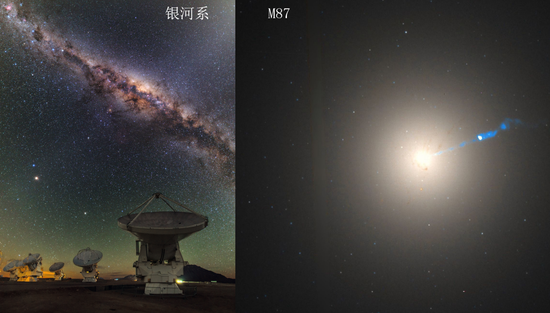
The two black holes they want to see are one from the center of the Milky Way galaxy and the other M87 black hole located approximately 55 million light years away. The black hole in the M87 optical band is shown on the right side of the image.
How large a telescope is needed to truly see the appearance of the central black hole? If we want to use the most advanced telescopes at present, the aperture of the telescope needs to reach about a few kilometers in order to distinguish the appearance of the central black hole.
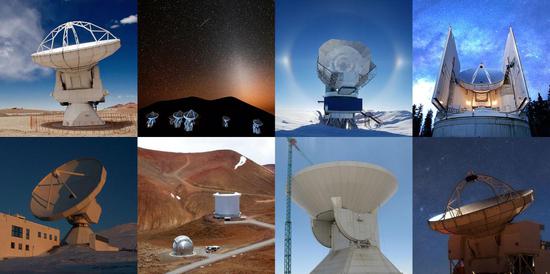
Scientists cannot manufacture such a huge optical telescope. They have developed a technology called VLBI networking, which connects almost all submillimeter wave telescopes around the world into a huge network. This telescope can reach an aperture of over 10000 kilometers to image the central black hole. These telescopes are usually located at very high altitudes to reduce the absorption of electromagnetic waves by the atmosphere.
In addition to the continuous improvement of observation equipment, a large amount of simulation is also needed in theory, as the surroundings of black holes are very complex. With simple paper and pen, it is difficult for scientists to describe the state of motion of gas around the black hole. At this time, relativistic magnetic fluid mechanics is required. Every calculation requires thousands of CPUs, and the calculation lasts for several months.
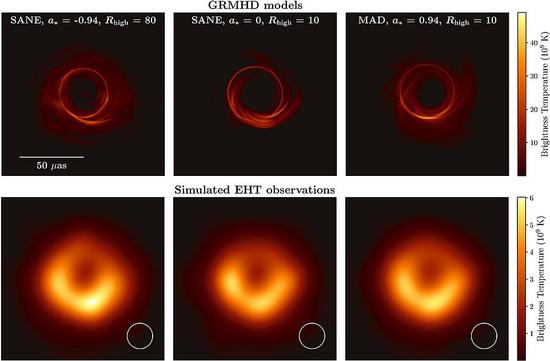
The Visual Interface Telescope team made final calculations for various scenarios, and the above figure shows some of the results obtained from the calculations. Finally, everything was ready. From April 10th to 15th, 2017, they used telescopes from 8 different parts of the world to observe these two black holes and ultimately obtained approximately 5 PB of data.
Because the amount of data is very large, and there is a telescope located at the South Pole. It is difficult to transfer data back using the existing network. Perhaps when 5G technology matures in the future, we can directly transmit it. The method adopted by scientists is to copy the data to disk and transport it back to the data center by plane.

There are two data centers, one located at MIT in the United States and the other in Germany. After obtaining the data, scientists conduct relevant analysis and use different methods to confirm the images. After confirmation, perform reconstruction and ultimately obtain the black hole photo we see. While obtaining photos of black holes, scientists have conducted numerical simulations and compared them with numerical simulation libraries to infer the properties of black holes. This is the first black hole photo released globally at 9pm on April 10, 2019.
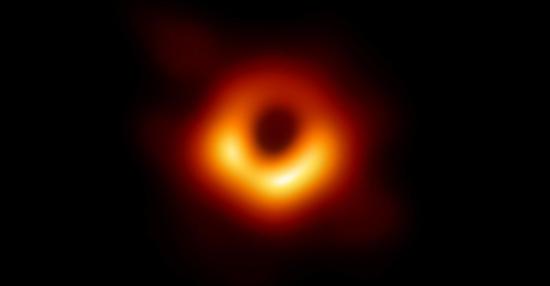
With black hole photos, scientists can infer the properties of black holes by comparing them with previously obtained numerical results. Perhaps everyone will be very impressed by the black holes in the movie 'Star Trek'. Of course, we cannot fly around M87 to make a direct comparison, but we can use modern high-performance computers to simulate the entire process. You may ask, "Why is the first black hole photo we saw this time so different from the one in the Star Trek movie.
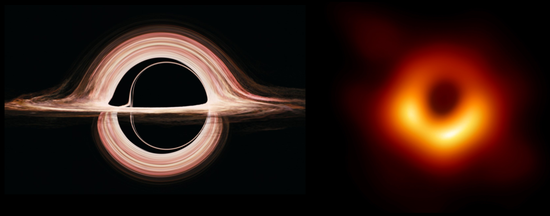
The main reason is that we view black holes from different perspectives. When shooting M87, we view it in the direction of the black hole's rotation, but in the movie 'Star Trek', the appearance of the black hole is displayed along the equatorial direction. This is the biggest difference between the two.
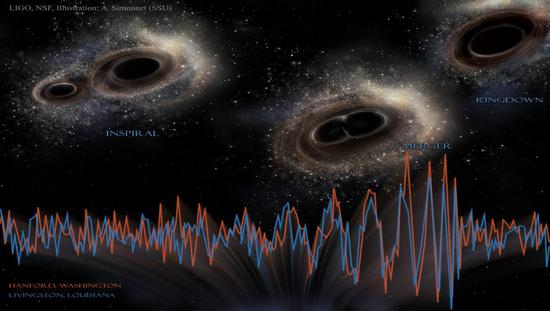
Modern technology not only brings great convenience to the study of black holes, but also gravitational waves are a topic worth discussing when discussing the impact of technology on astronomical research. Gravitational waves can be said to be ripples in spacetime, which are the enormous energy released by dense celestial bodies when colliding or exploding in the universe, creating waves in spacetime.
This fluctuation is very weak, and we know that hydrogen bombs are the most destructive weapon on Earth. The hydrogen bomb attempted by the former Soviet Union at that time reached 50 million tons equivalent, which can be said to be the most destructive of all hydrogen bombs. If we can stand at the center of the hydrogen bomb explosion and measure its interference with time and space, the interference is only 10 to the minus 27th power. The size of an atomic nucleus is 10 to the minus 18 square meters, and the size of a hair filament is 10 to the minus 5 square meters. By comparison, we can see that although this hydrogen bomb has caused great damage to surrounding objects, it has almost no damage to spacetime.
If one day a very powerful gravitational wave passes through Earth, what impact will it have on humans on Earth? It will continuously stretch humans.
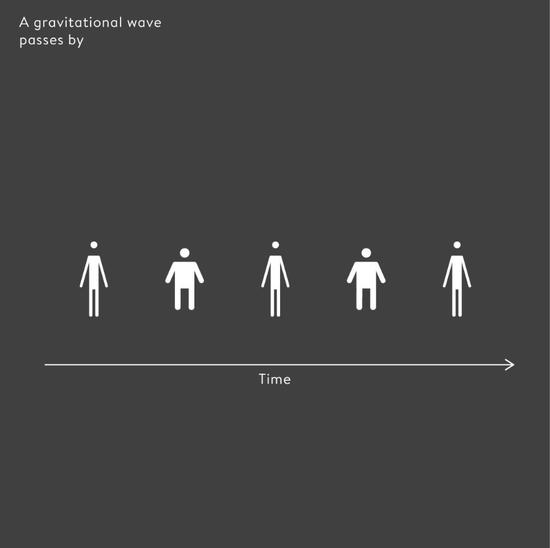
The above image shows the impact of gravitational waves on humans in an exaggerated way, where a person suddenly becomes thinner or fatter. But in reality, the changes in the human body caused by gravitational waves are not as big as a single atomic nucleus.
In September 2015, humans first detected gravitational waves, which were detected by the Gravitational Wave Laser Observatory in the United States. The effect of this gravitational wave only caused a change in the scale of an atom, which was only 10 to the minus 18 square meters.
This also indicates that our modern technology has been able to achieve such precise measurements.
From the introduction of general relativity in 1915, the prediction of gravitational waves in 1916, and the first direct detection of gravitational waves in 2015, humanity has gone through a century of exploration.
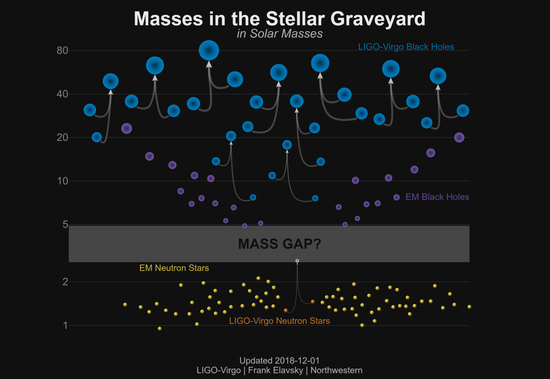
Gravitational waves have also helped humans discover many unexpected things. It turns out that we never expected that there would be many massive black holes in the universe. The purple origin represents the mass of a black hole seen through traditional telescopes, while the blue represents a very large black hole that gravitational waves help us discover. So, gravitational waves have become a new window for humans to explore black holes.
Next step: Take a dynamic photo of a black hole
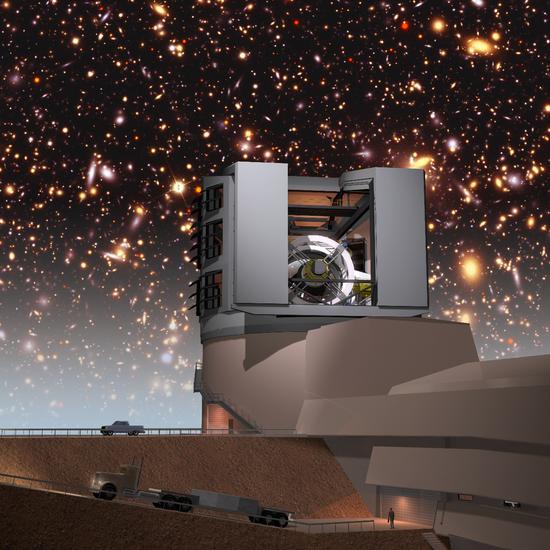
In the coming years, there will be other larger projects underway. For example, the LSST project in the United States (i.e. the Large Synaptic Survey Telescope). Many of the universes we see now are static universes. For example, we will see a very beautiful picture, and the purpose of this telescope is to create an animated image of the universe. Its data volume can reach 15TB per night, which is a significant challenge for current computing and processing capabilities.
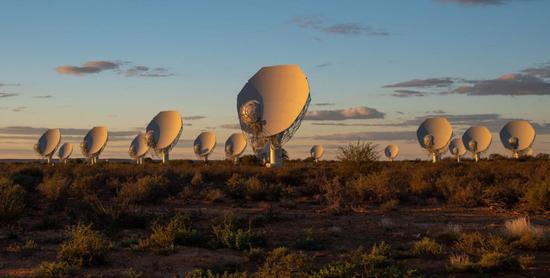
Of course, there are still more challenges waiting for us. Another large project that China participates in is the Square Kilometer Array radio telescope (SKA). It can reach a scale of over one square kilometer and contains over 20000 small telescopes, producing a data volume of 2TB per second. So, how to handle such a huge amount of data is indeed a very big challenge.
Throughout the development of human history of science, the development of modern science benefits from astronomical observation. In the past few decades, astronomy has benefited countless times from modern technology, which has helped scientists discover a broader and more magical universe. Astronomy, as a fundamental discipline, I deeply agree with the statement made by the President of Massachusetts Institute of Technology after the discovery of gravitational waves, He said, "Basic science is very laborious, rigorous, and slow, and it is also a very shocking, revolutionary, and catalytic research. Without basic disciplines, the best ideas cannot be improved, and innovation can only be minor. Only with the progress of basic science can our entire society make progress.
Please specify source if reproduced100 years later, humans finally saw a black hole | SCISOON

